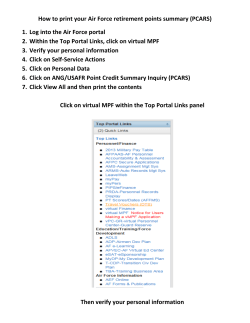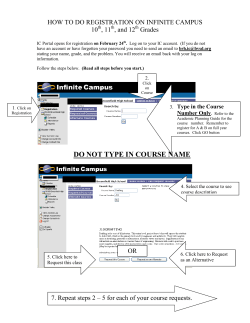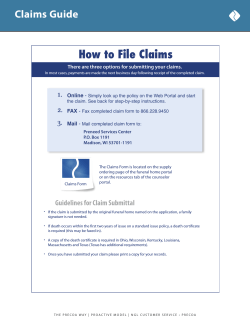
Adding Self-Service to Enterprise Service Management How We Did IT
How We Did IT Adding Self-Service to Enterprise Service Management How Infoblox Consumerized and Automated Services to Drive the Business Infoblox, the network control company, turned to ServiceNow to modernize its IT management infrastructure and adopt a service orientation to get work done. With the vision and leadership of Lisa Hummel, IT Operations Manager, the company simultaneously wanted to apply Enterprise Service Management for IT as well as other shared service departments. Situation ® Organization Infoblox About Infoblox One aspect critical to the success of the new service orientation approach was to provide an easy, intuitive way for employees to directly make requests that would then initiate automated workflows to fulfill or resolve the request. Using ServiceNow Service Catalog, Hummel created a centralized portal to offer common services and provide the means for knowing the status of a request at any point in time. Delivers network control solutions, the fundamental technology that connects end users, devices, and networks for over 7,300 enterprises and service providers to transform, secure, and scale complex networks. “I’ve talked to people from other companies and heard them say that they haven’t yet rolled out Service Catalog for their ServiceNow implementation,” said Hummel. “It’s such a missed opportunity, because it’s a way to get your customers engaged without a phone call or the ‘iffyness’ of an email. A lot of customers do that later in their journey. I think it’s so important to add it at the start.” Headquarters First Impressions Santa Clara, CA Geographies Global Business Technology Products ServiceNow IT Service Automation Suite, Service Catalog, Content Management System (CMS) www.servicenow.com In order to drive a new style of work based on creating and using services, Hummel knew that it was important to capture the imaginations of service requestors as well as fulfillers. “You need to show that it is easy and make it really clear how to get what you need with the least amount of effort.” By creating a self-service portal, companies can create a “one-stop shop” to fulfill needs in a simple, intuitive way. Hummel recognized that using the corporate look and feel makes a self-service portal even more familiar and compelling. With the capabilities of the ServiceNow Content Management System (CMS), Infoblox created style sheets with ServiceNow | 1 associated design elements and images to establish a consistent look and feel. Hummel decided that the portal should be intuitive and useful enough that users could start using it right away. Training was focused on the fulfillers to help them use the new processes most effectively. Shortly after going live with ServiceNow, Infoblox saw a strong rate of adoption by end-users. This has continued to increase. “It’s about first impressions. It’s absolutely about first impressions.” Initially Going Live with IT, Facilities and Enterprise Applications Rather than just introducing Enterprise Service Management for meeting user’s IT needs, Hummel had the vision also to apply the service automation model to other departments. “When we saw ServiceNow demonstrations and what other companies have achieved through self-service portals, it really opened our eyes,” said Hummel. “I started to realize that you can change people’s behavior if you offer something that offers a substantial change and is so easy to use. We decided to start with a three-department rollout.” Creating Automated, Consumerized Services Hummel worked with each service owner to determine which would be included in the portal as an automated service. “If you offer something to your customers and you do it the same way the majority of the time, it can be a service in the catalog,” said Hummel. “We would sit down with people and find out what they do a lot of.” From a long list of service requests, Hummel worked to get the list down to a smaller number for the initial rollout. “We would decide the most important items—the ones they couldn’t really live without.” These were generally services where automation would make the biggest difference to the requestor and the fulfiller. Between IT, Business Applications and Facilities, the team pared the list down to less than 30 catalog items. For the initial rollout, they decided to go live with the 19 most important ones. After successfully introducing the initial services, it’s easy to add others. “There is always a phase two,” said Hummel. “Don’t worry about what doesn’t make the first iteration. You can always do a phase two.” In developing an automated workflow for each service, Hummel made each fulfiller think through all of the steps that had to be accomplished and all of the information needed to complete a task. While this was a natural process for Hummel with her processoriented IT experience, it was a new experience for most of the fulfillers outside of IT. One of the essential benefits of Enterprise Service Automation is the ability to streamline and automate the approval process for a request. This brings significant benefits, including: • No more looking through spreadsheets to find the business owner • No more back and forth emails to obtain approval • No more wondering about the approval status or who has approved and who has not • No more hunting through email to try to find a request or check information; status can be displayed in the self-service portal • Approval requests can be given to a group rather than just individuals, so that the first available person can respond • There is an audit trail of the approval process that is centrally accessible • Fulfillers only perform the work once it is approved ServiceNow | 2 Enterprise Service Management for Facilities Top priorities for service automation: • Badge replacement • Cubicle set-up • Ergonomic assessments • Ergonomic equipment • Ordering office supplies • Catering • Cubicle moves Enterprise Service Management for Enterprise Software One key issue is the annual audit and truing up of licenses for various software applications. Now since requesting or renewing software applications comes through the self-service portal, IT always has current information about current users. Previously the process of auditing and licensing reporting was done manually. One IT analyst commented, “The test to check new Oracle User Responsibilities took me only 20 minutes instead of the 2-3 hours when I used Request Tracker.” www.servicenow.com “We process flowed everything and made them sit down and write out everything they need to know to get a job done,” said Hummel. She stresses that it is critical to get everything known and clarified to perform a service at the start. For instance, in a request for graphics services, determine all the details up front—usage, size, color, resolution, etc. “Don’t make the customer go back and forth.” The back and forth process is common to the manual ad hoc way of fulfilling requests. Someone will ask for something, and it is usually followed with a number of messages back and forth for further clarification. Such iterations add further time and effort to fulfill a request. Since fulfillers generally are aware of what details they need to know for a typical request, when the process is automated all of that information can be required at the time of request. “I ask them, in a perfect world what do you want from me so that you can fulfill this order,” said Hummel. It represents a change in thinking, but it’s an important step to make service automation effective. Once the IT team has determined what information needs to be captured, the task is broken up into steps. These steps are then put together into a workflow. “It’s really applying ITIL to work process outside of IT,” said Hummel. “We use a visual diagram to step flow the process: the request comes in and stops here, and this person does something. Then it goes to the next person and this other thing happens. Then these two people have to approve it…” Once the entire process is documented, the IT team can use the ServiceNow Service Automation platform to develop a form for capturing the information from a user and then set off an automated workflow to fulfill the request. It can then be added to the Service Catalog. Service Catalog and CMS Ensures Self-Service Success In creating an effective service catalog, Hummel recommends drawing it out and then having a creative expert use the ServiceNow CMS to develop a layout that is consistent with the company’s look and feel and is easy to use. Having a familiar look significantly helps adoption. Advice for Successful Adoption: • Whatever information is necessary to complete a service, require it as a mandatory field to be filled in by the requestor • Every chance you get, use a workflow and define a group, rather than an individual user, to minimize single points of failure in the system • Use out of the box processes from ServiceNow as much as possible • When considering the UI, pretend to be the end user – make it easy with three clicks or less to find a resource • Quality versus quantity – it’s better to have five solid catalog items than 15 mediocre ones • For each hour of work on a service catalog item, devote 80-90% of that time to testing (and be sure to test email notifications to the requestor, fulfiller and fulfiller group) • Ease user adoption - Use the same look and feel as your corporate website - Be consistent with the layout for all of the pages - Integrate with Active Directory or SSO • Provide your CMS developer with a sketch layout of the catalog; don’t leave them guessing ServiceNow | 3 Enterprise Service Management for Marketing Top priorities for service automation: • Graphics production • Editorial request • Proofreading • Order sales tools • Creation of web landing page • Order trade show assets • Capture product demo • Order video assets Other Departments to Add Enterprise Service Management • HR Initial concept for the Infoblox self-service portal. • Event planning • Onboarding and off boarding employees The live portal using ServiceNow Service Catalog and the Content Management System to present an intuitive, consumerized experience for employees. Each employee’s view of the portal page is customized, showing any open issues they have with the ability to instantly see the status for each. The buttons for “Report an Issue” and “Create a Request” cover multiple departments: IT, Facilities, Marketing, etc. © 2014 ServiceNow, Inc. All rights reserved. ServiceNow believes information in this publication is accurate as of its publication date. This publication could include technical inaccuracies or typographical errors. The information is subject to change without notice. Changes are periodically added to the information herein; these changes will be incorporated in new editions of the publication. ServiceNow may make improvements and/or changes in the product(s) and/ or the program(s) described in this publication at any time. Reproduction of this publication without prior written permission is forbidden. The information in this publication is provided “as is.” ServiceNow makes no representations or warranties of any kind, with respect to the information in this publication, and specifically disclaims implied warranties of merchantability or fitness for a particular purpose. ServiceNow and the ServiceNow logo are registered trademarks of ServiceNow. All other brand and product names are trademarks or registered trademarks of their respective holders. ServiceNow | 4
© Copyright 2025















